 Open Access
Open Access
ARTICLE
Numerical Study of Temperature-Dependent Viscosity and Thermal Conductivity of Micropolar Ag–MgO Hybrid Nanofluid over a Rotating Vertical Cone
1 Department of Mathematics, University of Eswatini, Kwaluseni, M201, Eswatini
2 Department of Mathematical Sciences, Sol Plaatje University, Kimberley, 8301, South Africa
3 Department of Mathematical and Computational Sciences, University of Venda, Thohoyandou, 0950, South Africa
* Corresponding Author: Mekonnen S. Ayano. Email:
(This article belongs to the Special Issue: Computational and Numerical Advances in Heat Transfer: Models and Methods I)
Frontiers in Heat and Mass Transfer 2024, 22(4), 1153-1169. https://doi.org/10.32604/fhmt.2024.048474
Received 08 December 2023; Accepted 29 January 2024; Issue published 30 August 2024
Abstract
The present paper examines the temperature-dependent viscosity and thermal conductivity of a micropolar silver ()−Magnesium oxide () hybrid nanofluid made of silver and magnesium oxide over a rotating vertical cone, with the influence of transverse magnetic field and thermal radiation. The physical flow problem has been modeled with coupled partial differential equations. We apply similarity transformations to the non-dimensionalized equations, and the resulting nonlinear differential equations are solved using overlapping grid multidomain spectral quasilinearization method. The flow behavior for the fluid is scrutinized under the impact of diverse physical constraints, which are illustrated graphically. The results of the skin friction coefficient and Nusselt number varying different flow parameters are presented in the form of a table. It is observed that the main flow of the hybrid nanofluid, nano particle fraction of silver and Magnesium/water, enhances compared to the mono-nano fluid as the coupling number increases. The application of studies like this can be found in the atomization process of liquids such as centrifugal pumps, viscometers, rotors, fans.Keywords
Thermal properties of most base fluids used in industry are low and do not address the needs of recent technology. Nowadays, effective active heat transfer methods like ultrasonic vibration have been explored by Delouei et al. [1]. Another mechanism involves adding nanoparticles to the base fluid to improve heat transfer; this approach, discussed by Siavashi et al. [2], utilizes nanoparticles, known as nanofluids, to overcome this deficiency. At present, a widely explored research area for enhancing the thermal conductivity of base fluids is nanotechnology, as investigated by Izadi et al. [3]. The nanofluids have widespread applications in various engineering and industrial processes. Applications of this nature encompass cooling systems, heat exchangers, geothermal and solar energy systems, and biomedicine, particularly in the realm of targeted drug delivery, as highlighted by Siavashi et al. [2]. A considerable number of researchers have discussed the flows of nanofluid and its applications [2–7]. Akmal et al. [8] observed that the heat transfer rate increases as the values of the thermophoresis parameter increase. Zeeshan et al. [9] analyzed a convective MHD nanofluid water/ethylene glycol based flow towards a vertical cone. Hady et al. [10] reported a rapid reduction in heat transfer rates due to an increase in the nanofluid’s temperature and the solid volume fraction. Liu et al. [11] proposed a
Nanoparticles such as
The behaviour of a hybrid nanofluid composed of
It is known that many of the industrially and technologically important fluids are non-Newtonian fluids. In this article, a non-Newtonian micropolar fluid is considered. The most common type of non-Newtonian micropolar fluid is a fluid with a micro-structure that may consist of rigid, randomly oriented particles suspended in a viscous medium. MHD flow and heat transfer of carbon nanotube (
Motivated by the aforementioned works, the present study extends the work of Malik et al. [29]. This extension is not a simple one as the authors aim to address a hybrid nanofluid with spin gradient viscosity for a non-Newtonian micropolar fluid, an aspect that was not covered in their study. Furthermore, this extension addresses a gap not explored in classical fluid dynamics, as far as our knowledge extends. We examine the effects of volumetric nanofractions, micropolar, and viscous fluids and compare their impacts.
2 Mathematical Formulation of the Problem
Consider an inverted isothermal rotating cone with a semi-vertical angle of
where
where
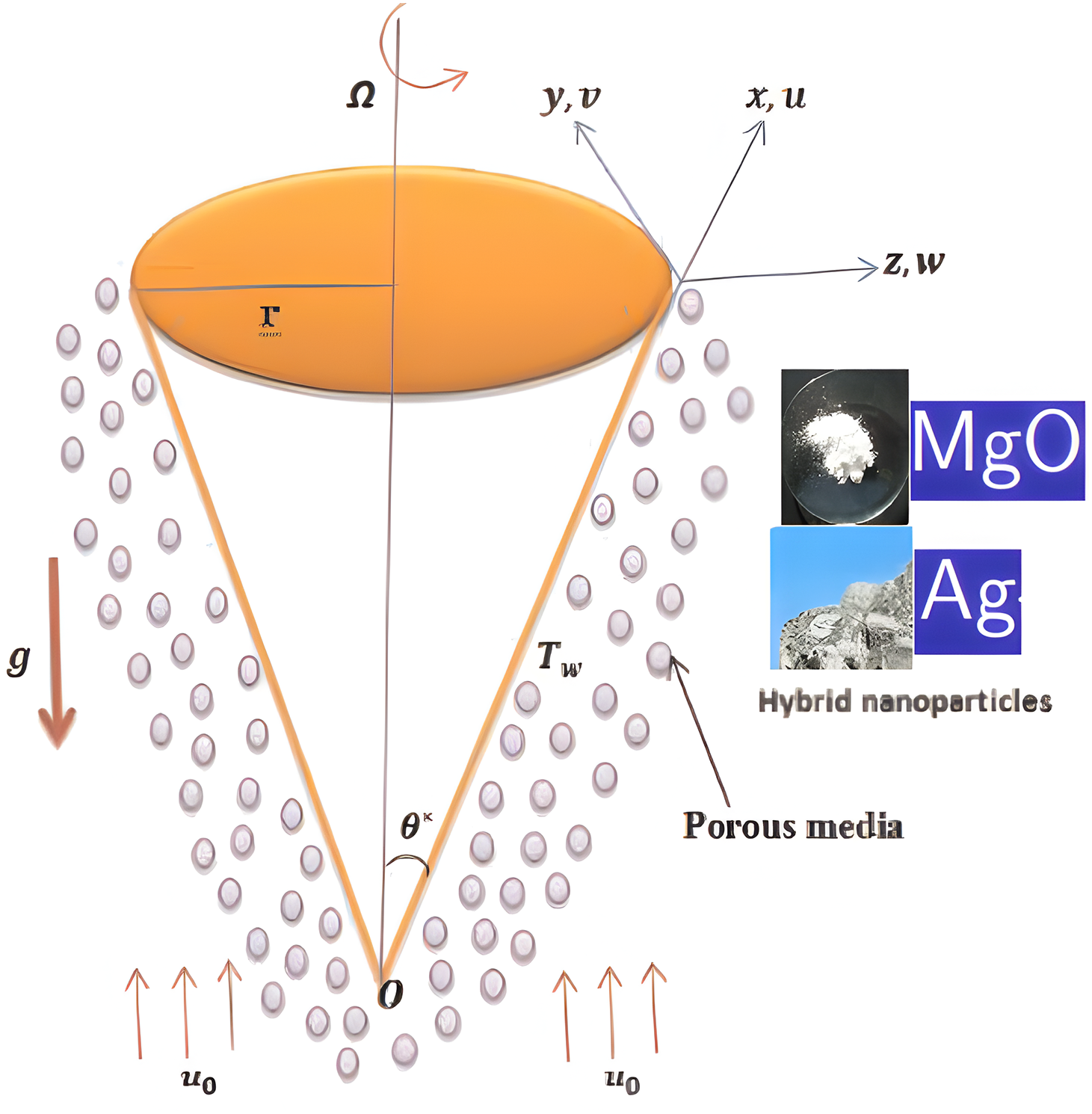
Figure 1: Geometry of the flow

According to Khan et al. [33], volume fraction, thermal conductivity, density, heat capacitance, thermal expansion coefficient, thermal conductivity and viscosity of the hybrid nanofluid, are defined by Eqs. (8)–(14), respectively:
Using Eqs. (6), (8)–(14) and the transformations specified by [29]:
the system of partial differential Eqs. (1)–(5) is transformed into ordinary differential Eqs. (15)–(18):
where
The nondimensional boundary conditions take the form:
The skin friction coefficient and local Nusselt number are defined as:
where
The corresponding non-dimensional form for Eqs. (20) and (21) are as follows:
where
Numerical solutions to the non-dimensionalized system of Eqs.(15)–(18) are obtained using the OGMDSQLM, proposed by Mkhatshwa [34]. The numerical solutions were generated through codes developed in MATLAB. The solution algorithm of this numerical method is based on numerical techniques namely QLM, spectral collocation, multidomain overlapping grid and Lagrange interpolation polynomials with Gauss-Lobatto-Chebyshev grid points. To implement the method, the integration domain,
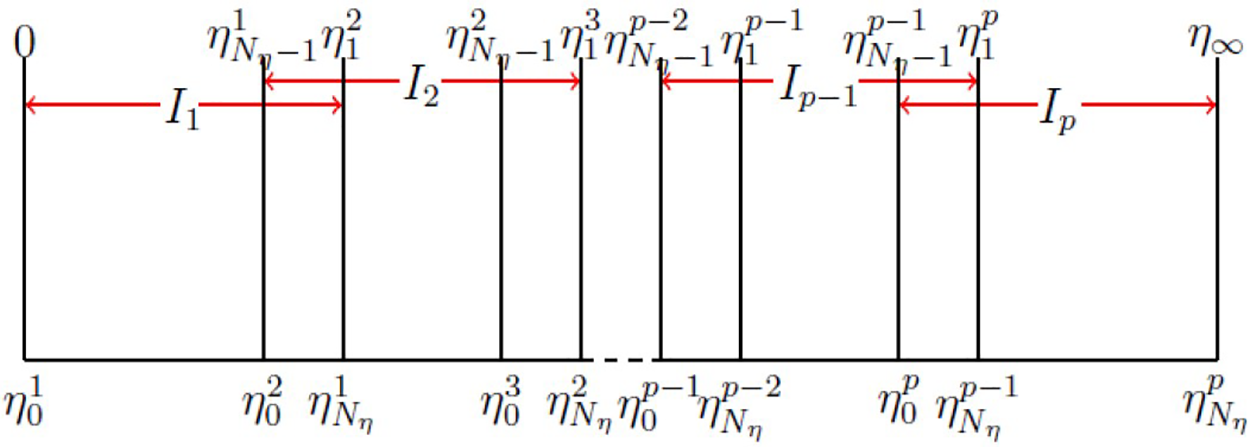
Figure 2: Overlapping grid, Mkhasthwa [34]
Using the SQLM method proposed by Motsa et al. [35], the coefficients of the unknowns are evaluated at the previous iteration level
As mentioned earlier, the essence of the overlapping grid multidomain spectral quasilinearization is the slicing of the physical domain into a finite number of overlapping subintervals, the non-dimensional boundary conditions then become as written in Eq. (30).
The linearized system of Eqs.(24)–(27) can be written compactly as shown in system (31), where
The system of Eq. (31) can be represented in matrix from as system (32). The column vectors of unknowns at a subinterval and current iteration level are:
where
and
Applying the pseudospectral method at the boundaries gives:
The OGMDSQLM leads to a sparse form of the coefficient matrix in system (32), which is expressed in its expanded form below, with the boundary conditions incorporated accordingly on the diagonal submatrices.
To begin the iterative search for approximate solutions, the following functions:
that satisfy the boundary conditions are taken as approximate solutions.
To check the validity of the current numerical scheme, a comparison of the present values of skin friction and Nusselt number with those published in the literature by Malik et al. [29], Chamkha et al. [36] is presented in Table 2. Using the nanoparticle volume fractions of hybrid nanofluid consisting of portions of nano particles

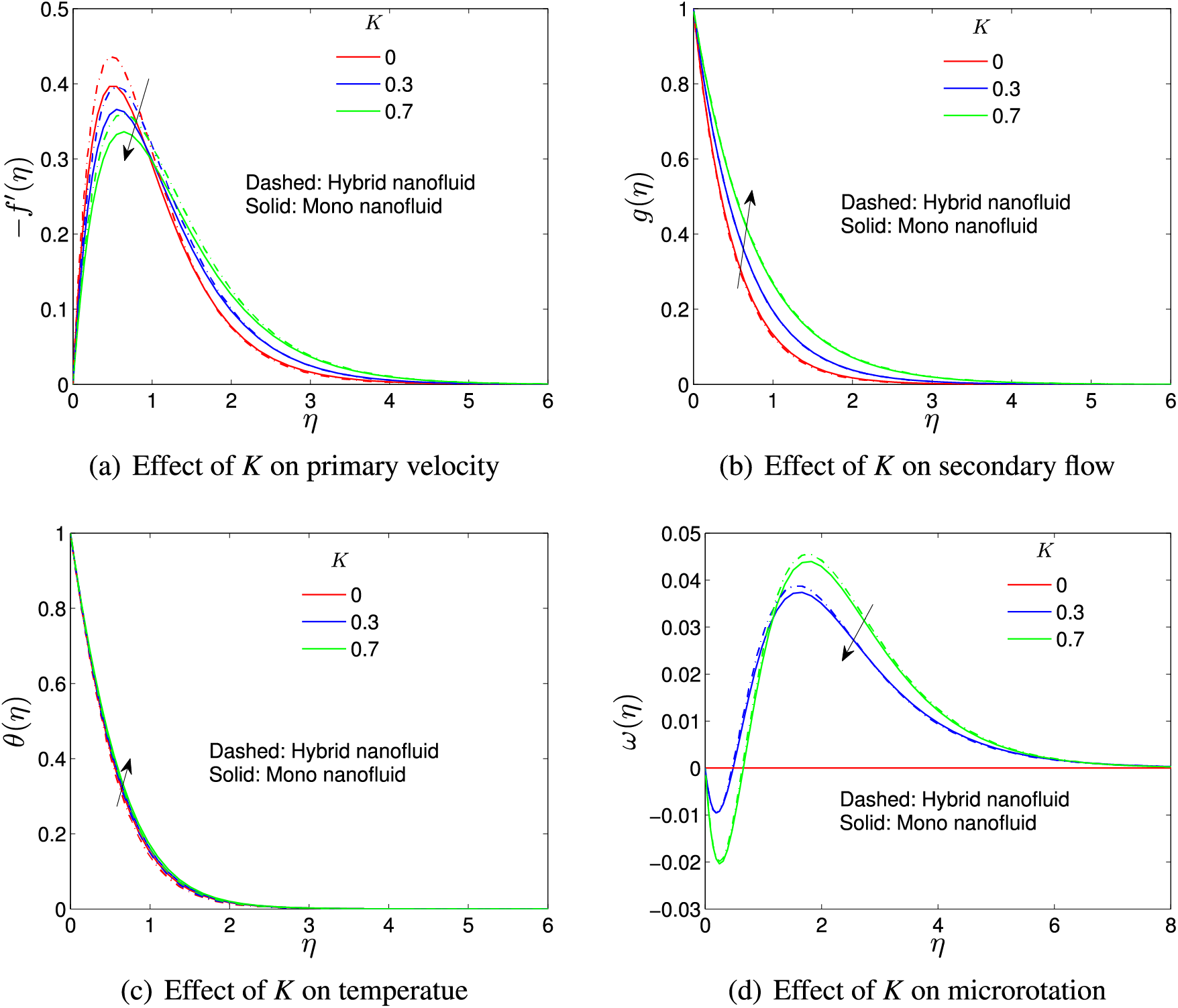
Figure 3: Coupling number effect
Fig. 4a shows that the smaller the variable viscosity parameter, the more the primary velocity diminishes. Physically, this implies that in the higher viscous region (near the boundary), the dominant force is buoyancy, and an increase in nanofluid concentration leads to an increase in velocity. The more hybrid nanofluid, the higher the thermal conductivity, which allows an increase in Brownian motion and, consequently, particle energy transfer. It is also interesting to note that away from the vicinity of the boundary, in the free stream region, the reverse effect is observed. However, it is evident from Fig. 4b that an increase in the variable viscosity parameter results in a decreasing effect on the secondary flow. This is because as the coupling number K increases, the fluid becomes more micropolar, and consequently, the particle sniping effect significantly retards the secondary flow. For the fractional volume of the hybrid nanofluid,
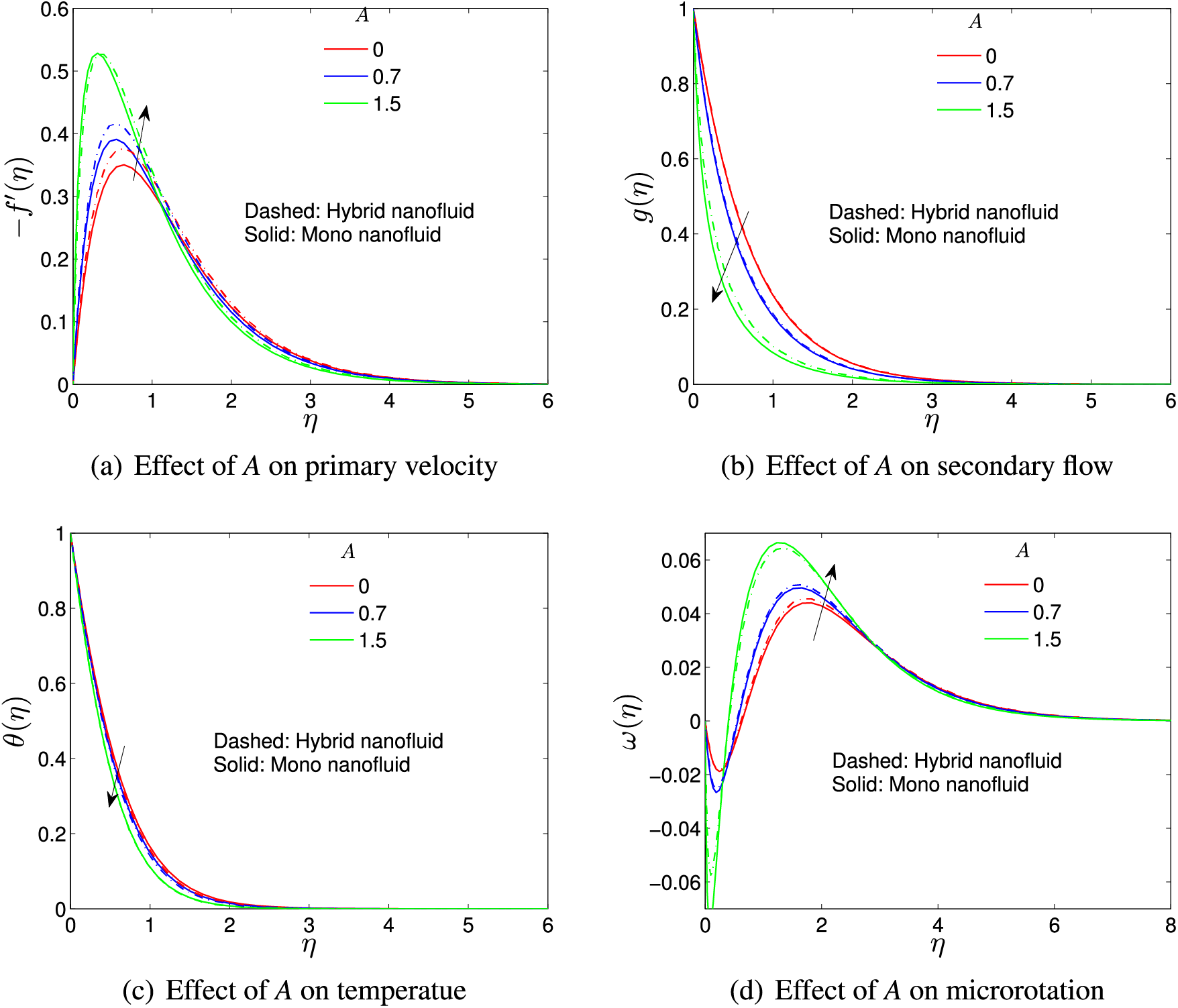
Figure 4: Variable viscosity parameter effect
Fig. 5a,b shows the impact of porosity parameter on both primary and secondary flows. It is clear from the figures that primary velocity decreases with an increase in the porosity parameter. The velocities of the hybrid nanofluid,
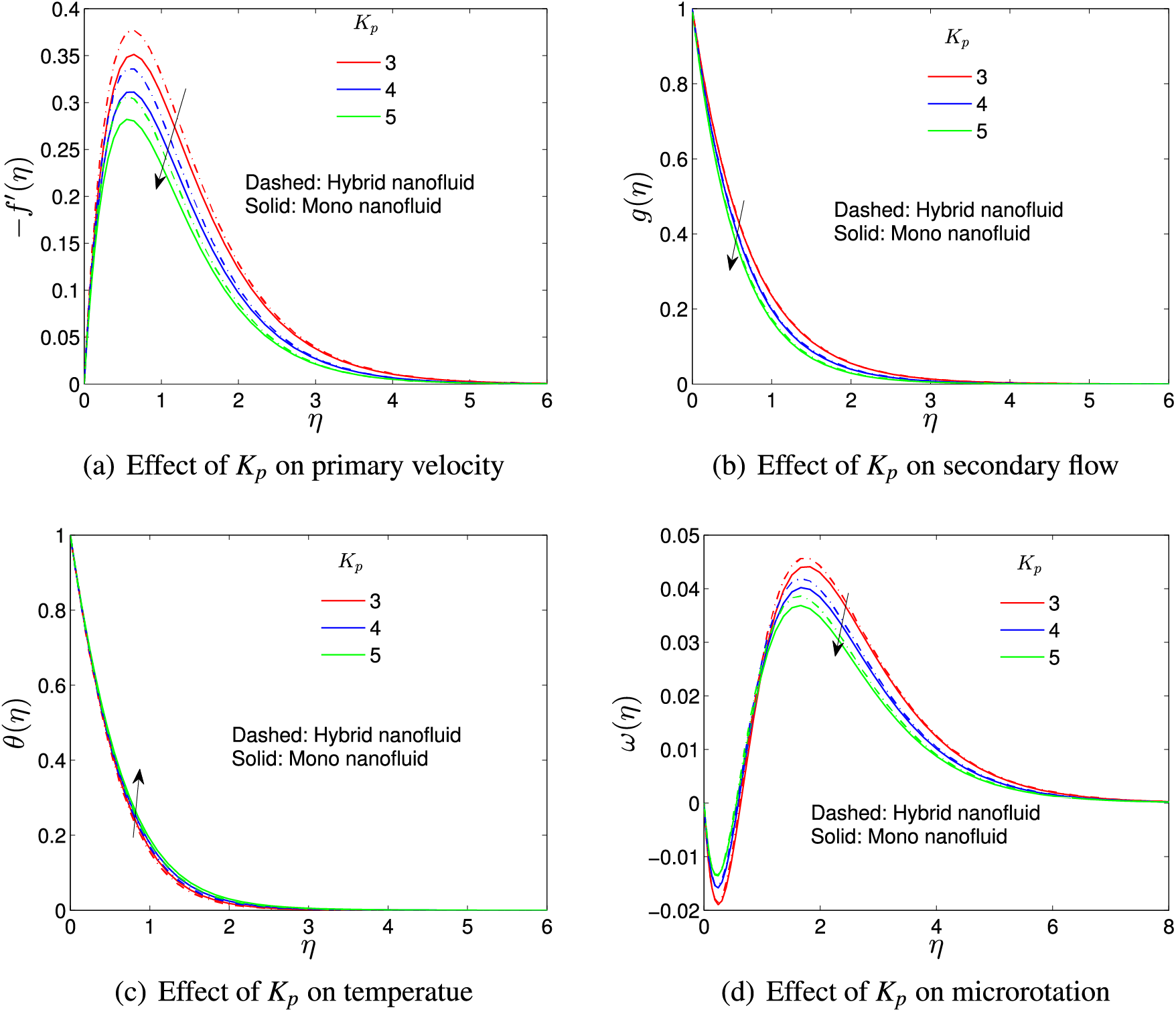
Figure 5: Porosity parameter effect
In Tables 3 and 4, the flow behaviour for different values of radiation and magnetic parameter on local sikin friction effect and Nusselt number are presented. The cases for mono-nanofluids


A numerical investigation for unsteady magneto micropolar
• Micropolar fluid assists the secondary flow and diminishes the main flow. The water hybrid nanofluid,
• The rotational effect for the hybrid nanofluid near the boundary is greater than that of the mono-nanofluid.
• For the water hybrid nanofluid,
• The variable viscosity parameter reduces the temperature for the hybrid nanofluid,
• The porosity parameter decreases the main flow; however, the inclusion of the hybrid nanofluid
Acknowledgement: The authors would like to thank the anonymous reviewers for their valuable comments.
Funding Statement: The authors received no specific funding for this study.
Author Contributions: The authors confirm contribution to the paper as follows: conceptualisation: Mekonnen S. Ayano; writing original draft: Mekonnen S. Ayano; methodology, code writing: Thokozani N. Khumalo, Stephen T. Sikwila; Matlab code creation and validation: Mekonnen S. Ayano, Thokozani N. Khumalo, Stephen T. Sikwila; analysis and interpretation of results: Mekonnen S. Ayano, Stanford Shateyi; final manuscript preparation: Mekonnen S. Ayano, Stephen T. Sikwila; validation of results: Mekonnen S. Ayano, Stanford Shateyi. All authors reviewed the results and approved the final version of the manuscript.
Availability of Data and Materials: The readers can contact the corresponding author and request the Matlab codes used to generate the data.
Conflicts of Interest: The authors declare that they have no conflicts of interest to report regarding the present study.
References
1. Delouei A, Atashafrooz M, Hasan S, Karimnejad S. The thermal effects of multi-walled carbon nanotube concentration on an ultrasonic vibrating finned tube heat exchanger. Int Comm Heat Mass Trans. 2022;135:106098. [Google Scholar]
2. Siavashi M, Miri J, Seyed M. Numerical performance analysis of a counter-flow double-pipe heat exchanger with using nanofluid and both sides partly filled with porous media. J Therm Anal Calorim. 2018;135(2):1595–610. [Google Scholar]
3. Izadi A, Siavashi M, Xiong Q. Impingement jet hydrogen, air and Cu-H2O nanofluid cooling of a hot surface covered by porous media with non-uniform input jet velocity. Int J Hydrogen Energy. 2019;44(3015933–48. [Google Scholar]
4. Saleh H, Alali E, Ebaid A. Medical applications for the flow of carbon-nanotubes suspended nanofluids in the presence of convective condition using laplace transform. J Assoc Arab Univ Basic Appl Sci. 2017;24(1):206–12. [Google Scholar]
5. Wong KV, De Leon O. Applications of nanofluids: current and future. Adv Mech Eng. 2010;2:519659–70. [Google Scholar]
6. Mkhatshwa M, Motsa S, Ayano M, Sibanda P. MHD mixed convective nanofluid flow about a vertical slender cylinder using overlapping multi-domain spectral collocation approach. Case Stud Therm Eng. 2020;18:100598. doi:10.1016/j.csite.2020.100598. [Google Scholar] [CrossRef]
7. Thameem BH, Sivaraj R, Subramanyam RA, Chamkha AJ. SWCNH/diamond-ethylene glycol nanofluid flow over a wedge, plate and stagnation point with induced magnetic field and nonlinear radiation-solar energy application. Eur Phys J Spec Top. 2019;228(12):2531–51. doi:10.1140/epjst/e2019-900048-x. [Google Scholar] [CrossRef]
8. Akmal N, Sagheer M, Hussain S, Kamran A. Investigation of free convection in micropolar nanofluid with induced magnetic field. Eur Phys J Plus. 2019;134(5):179. doi:10.1140/epjp/i2019-12512-7. [Google Scholar] [CrossRef]
9. Zeeshan A, Ellahi R, Hassan M. Magnetohydrodynamic flow of water/ethylene glycol based nanofluids with natural convection through a porous medium. Eur Phys J Plus. 2014;129(12):123. doi:10.1140/epjp/i2014-14261-5. [Google Scholar] [CrossRef]
10. Hady FM, Ibrahim FS, Abdel-Gaied SM, Eid MR. Radiation effect on viscous flow of a nanofluid and heat transfer over a nonlinearly stretching sheet. Nanoscale Res Lett. 2012;7(1):26. doi:10.1186/1556-276X-7-229. [Google Scholar] [CrossRef]
11. Liu L, Miao P, Xu Y, Tian Z, Zou Z, Li G. Study of PT/TiO2 nanocomposite for cancer-cell treatment. J Photochem Photobiol B: Biol. 2010;98(3):207–10. doi:10.1016/j.jphotobiol.2010.01.005. [Google Scholar] [CrossRef]
12. Noghrehabadi A, Behseresht A, Ghalambaz M, Behseresht J. Natural-convection flow of nanofluids over vertical cone embedded in Non-Darcy porous media. J Thermophys Heat Trans. 2013;27(2):334–41. doi:10.2514/1.T3965. [Google Scholar] [CrossRef]
13. Sheikholeslami M, Gorji Bandpy M, Ellahi R, Hassan M, Soleimani S. Effects of mhd on cu-water nanofluid flow and heat transfer by means of CVFEM. J Magn Magn Mater. 2014;349(6):188–200. doi:10.1016/j.jmmm.2013.08.040. [Google Scholar] [CrossRef]
14. Afify AA. The effect of radiation on free convective flow and mass transfer past a vertical isothermal cone surface with chemical reaction in the presence of a transverse magnetic field. Can J Phys. 2004;82(6):447–58. doi:10.1139/p04-009. [Google Scholar] [CrossRef]
15. Makinde O, Aziz A. Boundary layer flow of a nanofluid past a stretching sheet with a convective boundary condition. Int J Therm Sci. 2011;50(7):1326–32. doi:10.1016/j.ijthermalsci.2011.02.019. [Google Scholar] [CrossRef]
16. Mehmood Z, Mehmood R, Iqbal Z. Numerical investigation of micropolar casson fluid over a stretching sheet with internal heating. Commun Theor Phys. 2017;67(4):443. doi:10.1088/0253-6102/67/4/443. [Google Scholar] [CrossRef]
17. El-Kabeir SMM, Abdou MM. Chemical reaction, heat and mass transfer on MHD flow over a vertical isothermal cone surface in micropolar fluids with heat generation/absorption. Appl Math Sci. 2007;1: 1663–74. [Google Scholar]
18. Parveen K, Banse V, Ledwani L, Green synthesis of nanoparticles: Their advantages and disadvantages. AIP Conf Proc. 2016;1724:020048. doi:10.1063/1.4945168. [Google Scholar] [CrossRef]
19. Chahregh HS, Dinarvand S. TiO2-Ag/blood hybrid nanofluid flow through an artery with applications of drug delivery and blood circulation in the respiratory system. Int J Numer Methods Heat Fluid Flow. 2020;30(11):4775–96. doi:10.1108/HFF-10-2019-0732. [Google Scholar] [CrossRef]
20. Ali K, Ahmad S, Ahmad S, Tayebi T. Impact of magnetic field localization on the vortex generation in hybrid nanofluid flow. J Thermal Anal Calorim. 2023;148(13):6283–300. doi:10.1007/s10973-023-12104-5. [Google Scholar] [CrossRef]
21. Bhatti MM, Abbas T, Rashidi M. Effects of thermal radiation and electromagnetohydrodynamics on viscous nanofluid through a riga plate. Multidiscip Model Mater Struct. 2016;12(4):605–18. doi:10.1108/MMMS-07-2016-0029. [Google Scholar] [CrossRef]
22. Liu Y, Jian Y, Tan W. Entropy generation of electromagnetohydrodynamic (EMHD) flow in a curved rectangular microchannel. Int J Heat Mass Trans. 2018;127:901–13. doi:10.1016/j.ijheatmasstransfer.2018.06.147. [Google Scholar] [CrossRef]
23. Bilal M, Mazhar SZ, Ramzan M, Mehmood Y. Time-dependent hydromagnetic stagnation point flow of a Maxwell nanofluid with melting heat effect and amended Fourier and Fick’s laws. Heat Trans. 2021;50(5):4417–34. doi:10.1002/htj.22081. [Google Scholar] [CrossRef]
24. Ghadikolaei S, Hosseinzadeh K, Ganji D. Numerical study on magnetohydrodynic CNTS-water nanofluids as a micropolar dusty fluid influenced by non-linear thermal radiation and joule heating effect. Powder Technol. 2018;340:389–99. doi:10.1016/j.powtec.2018.09.023. [Google Scholar] [CrossRef]
25. Sandeep N, Samrat SP, Ashwinkumar GP. Flow and heat transfer in radiative MHD dusty-hybrid ferrofluids. Waves Random Complex Media. 2022;66:1–14. doi:10.1080/17455030.2022.2036866. [Google Scholar] [CrossRef]
26. Nazar R, Amin N, Grosan T, Pop I. Free convection boundary layer on a sphere with constant surface heat flux in a micropolar fluid. Int Commun Heat Mass Trans. 2002;29(8):1129–38. doi:10.1016/S0735-1933(02)00441-4. [Google Scholar] [CrossRef]
27. Braga VM, Barbosa JR, Deschamps C. Numerical investigation of refrigerant outgassing in the screw pump of a hermetic reciprocating compressor oil supply system. Proc Inst Mech Eng, Part E: J Process Mech Eng. 2020;236(1):87–93. doi:10.1177/0954408920952609. [Google Scholar] [CrossRef]
28. Rehman F, Khan MI, Sadiq M, Malook A. MHD flow of carbon in micropolar nanofluid with convective heat transfer in the rotating frame. J Mol Liq. 2017;231:353–63. doi:10.1016/j.molliq.2017.02.022. [Google Scholar] [CrossRef]
29. Malik M, Jamil H, Salahuddin T, Bilal S, Rehman K, Mustafa Z. Mixed convection dissipative viscous fluid flow over a rotating cone by way of variable viscosity and thermal conductivity. Results Phys. 2016;6(7):1126–35. doi:10.1016/j.rinp.2016.11.027. [Google Scholar] [CrossRef]
30. Ahmad S, Ali K, Bashir H. Interaction of micropolar fluid structure with the porous media in the flow due to a rotating cone. Alex Eng J. 2021;60(1):1249–57. doi:10.1016/j.aej.2020.10.048. [Google Scholar] [CrossRef]
31. Ayano M, Motsa S, Otegbeye O. A paired quasilinearization method for solving the MHD mixed convection flow of a micropolar fluid through a truncated cone in a non-darcy porous medium. Theor Appl Mech. 2019;46(2):173–89. doi:10.2298/TAM190801011S. [Google Scholar] [CrossRef]
32. Hiba B, Redouane F, Jamshed W, Ahamed SC, Suriya UDS, Prakash M, et al. A novel case study of thermal and streamline analysis in a grooved enclosure filled with (Ag-MgO/Water) hybrid nanofluid: galerkin FEM. Case Stud Therm Eng. 2021;28:101372. [Google Scholar]
33. Khan MI, Alzahrani F. Free convection and radiation effects in nanofluid (silicon dioxide and molybdenum disulfide) with second order velocity slip, entropy generation, Darcy-Forchheimer porous medium. Int J Hydrogen Energy. 2021;46(1):1362–9. [Google Scholar]
34. Mkhatswa MP. Overlapping grid spectral collocation methods for nonlinear differential equations modelling fluid flow problems (Ph.D. dissertation). University of KwaZulu-Natal: South Africa; 2020. [Google Scholar]
35. Motsa SS, Sibanda P, Shateyi S. On a new quasi-linearization method for systems of nonlinear boundary value problems. Math Methods Appl Sci. 2011;34(11):1406–13. [Google Scholar]
36. Chamkha AJ, Al-Mudhaf A. Unsteady heat and mass transfer from a rotating vertical cone with a magnetic field and heat generation or absorption effects. Int J Therm Sci. 2005;44(3):267–76. [Google Scholar]
Cite This Article
 Copyright © 2024 The Author(s). Published by Tech Science Press.
Copyright © 2024 The Author(s). Published by Tech Science Press.This work is licensed under a Creative Commons Attribution 4.0 International License , which permits unrestricted use, distribution, and reproduction in any medium, provided the original work is properly cited.


 Submit a Paper
Submit a Paper Propose a Special lssue
Propose a Special lssue View Full Text
View Full Text Download PDF
Download PDF Downloads
Downloads
 Citation Tools
Citation Tools